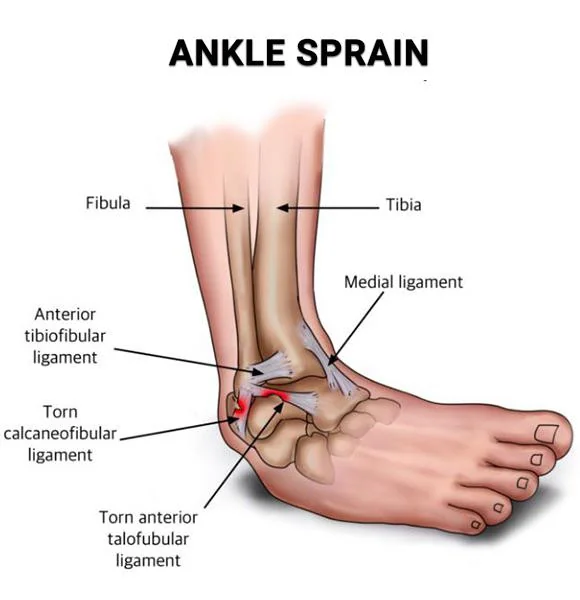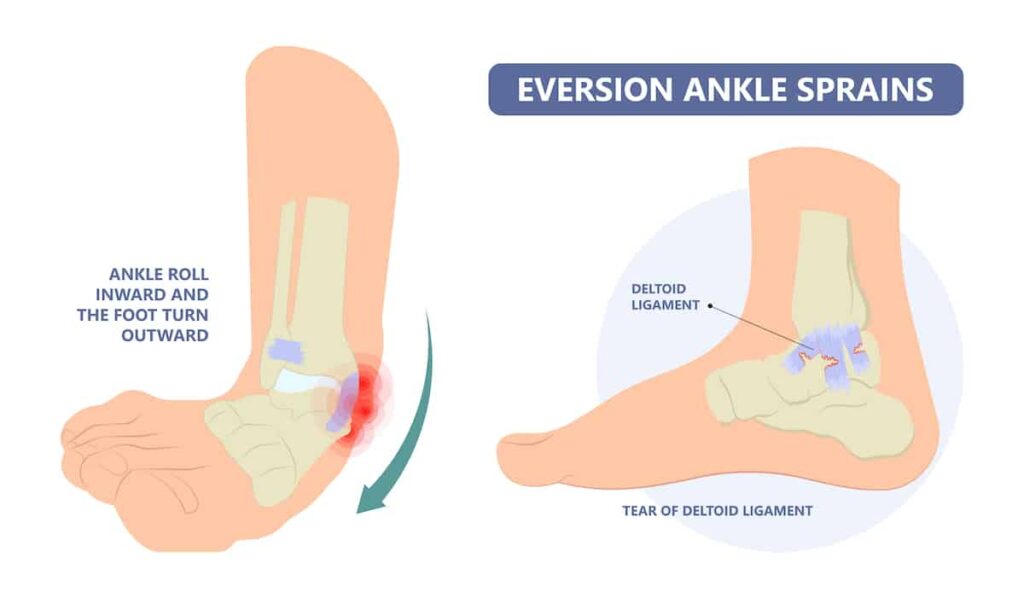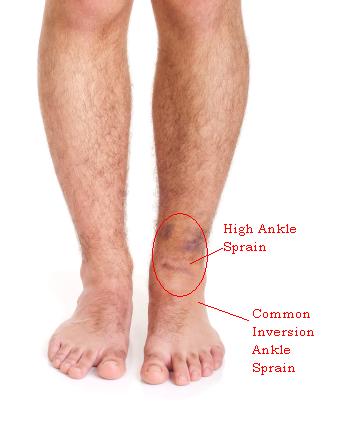Discover the key to preventing and treating ankle sprains with our in-depth guide. Learn about the causes, types, and recovery strategies to keep your ankles strong and healthy.

Introduction
Ankle sprains are a common yet often misunderstood injury, affecting individuals across all walks of life. From sudden twists to improper footwear, this guide delves into the anatomy of ankle sprains, offering expert advice on prevention, diagnosis, and recovery. Whether you’re an athlete or an everyday adventurer, understanding ankle sprains is your first step towards resilient health.
Table of Contents
Exploring Ankle Sprains: A Detailed Overview
An ankle sprain is a common injury that occurs when the foot is twisted, rolled, or turned in an unnatural way. This action can stretch or even tear the ligaments that hold the ankle bones together, leading to discomfort, swelling, and a restricted range of motion. Such injuries are prevalent across various activities, affecting not only professional athletes but also individuals engaging in everyday walking.

Understanding the Causes and Risk Factors for Ankle Sprains: Strategies for Prevention
Ankle sprains stem from a variety of scenarios and conditions. Below, we delve into the main causes and risk factors, offering insights on how to prevent these injuries.
Sudden Movements and Changes in Direction
Cause: Quick changes in movement or direction can place excessive stress on the ankle ligaments. This is particularly true in sports that involve sudden pivoting, such as basketball, soccer, or tennis.
Prevention Strategy: Focus on exercises that enhance agility and balance. Boosting proprioception, or the awareness of the position of your ankle, can aid in stabilizing the joint and lowering the risk of sprains.
Navigating Uneven Surfaces
Cause: Traversing irregular terrains can cause the foot to land awkwardly, increasing the likelihood of twisting the ankle.
Prevention Strategy: Be mindful of your path when walking or running, and choose footwear with good traction and support. Take extra caution on uneven surfaces to reduce injury risk.
Wearing Inappropriate Shoes
Cause: Shoes that lack proper support or don’t fit correctly can make the ankle less stable. High heels, for instance, can heighten the risk, as can old or worn-out athletic shoes that no longer provide adequate support.
Prevention Strategy: Opt for shoes that are suitable for your activity, ensuring they fit well and offer sufficient ankle support. Regularly replace athletic shoes to preserve their protective features.
History of Ankle Injuries
Cause: An ankle that has previously been sprained is more susceptible to future sprains, particularly if it hasn’t completely healed or was not fully rehabilitated.
Prevention Strategy: Ensure complete rehabilitation of any ankle injuries before resuming full activities. Consider using ankle supports, like braces or tape, as a precaution during physical activities.
Other Risk Factors to Consider
Physical Fitness: A body that is in good physical condition is less prone to ankle sprains. Strengthening the muscles around the ankle can provide better support and stabilization.
Age and Activity Level: While active individuals and athletes face a higher risk of ankle sprains, no age group is immune. It’s important to remain cautious, regardless of your age or level of activity.
Body Weight: Excess weight can put additional pressure on the ankles, elevating the risk of sprains both during physical activities and in daily life.
By understanding these causes and risk factors and taking steps to mitigate them, you can significantly lower your chances of suffering an ankle sprain. In the event of an injury, it’s imperative to seek proper care and rehabilitation to ensure a complete recovery and to prevent future issues.
Exploring the Types of Ankle Sprains and Their Diagnosis
Ankle sprains are a frequent occurrence, impacting numerous people every day through activities that cause the ankle to twist or turn in an unnatural manner. This results in the stretching or tearing of the ligaments that support the ankle. There are three main categories of ankle sprains, each differing in severity and the specific ligaments affected. Below is an examination of each type:
1. Inversion Sprains
Overview
Inversion sprains occur when the foot rolls inward excessively, putting undue stress on the outer ligaments of the ankle. This is the most common type of ankle sprain due to the ankle’s natural movement range and structure, which leaves the outer ligaments more vulnerable to injury.
Affected Ligaments
The ligaments typically involved include the anterior talofibular ligament (ATFL), the calcaneofibular ligament (CFL), and sometimes the posterior talofibular ligament (PTFL).
Symptoms
Symptoms can range from mild to severe and often include pain on the outside of the ankle, swelling, bruising, and limited ankle mobility.


2. Eversion Sprains
Overview
Eversion sprains occur with the outward rolling of the foot, stretching or tearing the ligaments on the inner side of the ankle. These sprains are less common due to the stronger ligaments on the medial side and the foot’s limited outward movement capability.
Affected Ligaments
The primary ligament affected is the deltoid ligament, which provides significant support to the medial side of the ankle.
Symptoms
Individuals may experience pain, swelling, and tenderness on the inner side of the ankle, with the severity depending on the extent of ligament damage.
3. High Ankle Sprains
Overview
High ankle sprains involve the ligaments that connect the tibia and fibula (the lower leg bones) above the ankle. These sprains are often the result of a rotational force applied to the ankle and are considered more severe, requiring a longer recovery time.
Affected Ligaments
The syndesmotic ligaments, including the anterior inferior tibiofibular ligament (AITFL), the posterior inferior tibiofibular ligament (PITFL), and the interosseous membrane, are typically involved.
Symptoms
Symptoms include severe pain during foot push-off or when squeezing the lower leg bones together, along with swelling and bruising around the ankle joint.

Diagnosing Ankle Sprains: A Comprehensive Approach
Proper diagnosis of an ankle sprain is essential for creating an effective treatment plan. The diagnostic process includes physical examinations, reviewing the patient’s medical history, and conducting imaging tests.
Physical Examination:
A healthcare provider will assess the ankle for swelling, discoloration, and movement limitations. Palpation of the foot and ankle helps pinpoint the injury’s location and the severity of pain and swelling.
Medical History:
Details of how the injury occurred, such as through a fall or direct impact, are crucial. Previous ankle injuries are also considered to identify any pre-existing vulnerabilities.
Imaging Tests:
- X-rays are used to rule out bone fractures.
- Magnetic Resonance Imaging (MRI) provides detailed images of the ankle’s soft tissues, including the ligaments, for complex cases.
- Ultrasound allows for real-time visualization of the soft tissue structures, aiding in assessing ligament integrity and potential tears.
Grading of Ankle Sprains

Ankle sprains are graded based on severity:
- Grade 1 (Mild): Indicates slight stretching and microscopic tears of the ligament, leading to tenderness and swelling but retaining most functional abilities.
- Grade 2 (Moderate): Involves a partial tear of the ligament, causing moderate pain, swelling, and some joint instability, which may affect walking and weight-bearing.
- Grade 3 (Severe): Represents a complete tear or rupture of the ligament, resulting in significant swelling, bruising, instability, and an inability to bear weight on the affected ankle.
Effective Treatment and Recovery Methods for Ankle Sprains
Addressing ankle sprains involves strategies aimed at alleviating pain and facilitating the healing process. The RICE method is often the first line of treatment recommended for managing the initial symptoms.
Strategies for Pain Relief and Healing
Pain Management: Over-the-counter medications such as ibuprofen or acetaminophen can be beneficial for alleviating pain and reducing inflammation caused by ankle sprains.
Physical Rehabilitation: As the healing process advances, physical therapy plays a vital role. Its goals include strengthening the muscles around the ankle, improving flexibility, and preventing future sprains.
Prevention of Ankle Sprains
Adopting preventive measures is crucial for reducing the likelihood of experiencing ankle sprains:
Supportive Footwear: Choosing shoes that provide adequate support is essential, especially during activities that exert pressure on the ankles.
Ankle Strengthening Exercises: Engaging in exercises designed to strengthen the ankle can significantly improve joint stability.
Effective Warm-up Routines: Performing a thorough warm-up before exercise is key to preparing the muscles and ligaments, thereby minimizing the risk of sprains.
Frequently Asked Questions

Q: What causes ankle sprains?
A: Ankle sprains are typically caused by sudden movements, uneven surfaces, inappropriate footwear, and previous ankle injuries. Understanding these factors can help in prevention.
Q: How can I prevent ankle sprains?
A: Preventive measures include wearing supportive footwear, engaging in ankle strengthening exercises, and adopting effective warm-up routines before physical activities.
Q: What are the different types of ankle sprains?
A: Ankle sprains are categorized into inversion sprains, eversion sprains, and high ankle sprains, each affecting different ligaments and varying in severity.
Q: How are ankle sprains diagnosed?
A: Diagnosis involves a physical examination, medical history review, and imaging tests like X-rays, MRI, or ultrasound to assess the extent of the injury.
Q: What are some effective treatments for ankle sprains?
A: Initial treatments include the RICE method, pain management medications, and physical rehabilitation to strengthen the ankle and prevent future sprains.
Conclusion
Ankle sprains, while common, can be effectively managed and prevented with the right knowledge and care. By understanding the causes, types, and treatments, you can protect your ankles and maintain your active lifestyle. Remember, prevention is key, and early treatment can make all the difference in a swift and successful recovery.



MOST COMMENTED
Animal-Based Proteins / Casein Protein / Dietary Protein / High-Protein Diets / Pea Protein / Plant-Based Proteins / Protein / Protein Deficiency / Protein Supplements / Proteins / Whey Protein / Whey Proteins
Is Protein Powder Safe for Teenagers and Children?
Animal-Based Proteins / Casein Protein / Dietary Protein / High-Protein Diets / Pea Protein / Plant-Based Proteins / Protein / Protein Deficiency / Protein Supplements / Proteins / Whey Protein / Whey Proteins
Unlock the Power of Proteins for Optimal Gut Health
Multivitamin
Total Health: Multivitamin for Active Lifestyles
Multivitamin
WellnessFusion: Complete Multivitamin Support
Dietary Supplement
Revitalize Your Health: The Magic of Red Yeast Rice Capsules
Foot care / Foot Health
Revitalize Your Foot Care Routine: Essential Tips for Optimal Foot Health
Foot Problem / Diabetics / Foot Health
Diabetics: Mastering Footwear Selection for Enhanced Foot Health and Ultimate Comfort
Exercises and Footwear Tips for Hammertoe Relief / Foot care / Foot Health / Foot Pain / Foot Problem / Hammertoes
Unlock Effective Exercises and Footwear Tips for Hammertoe Relief
Hammertoes / Foot Health / Foot Pain / Foot Problem
Unlock Relief: Essential Guide to Hammertoes Causes, Symptoms, and Treatments
Foot Problem / Foot Health
Revolutionize Your Recovery: Natural Remedies for Plantar Fasciitis – Fresh Home Keepers